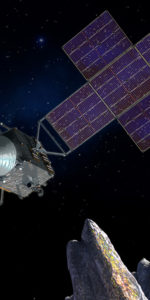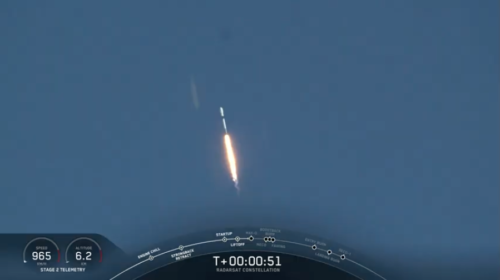
B1051 punches through low-level murk and into crystal-clear California skies, beginning its effort to deliver three Radarsat Constellation Mission (RCM) satellites into near-polar orbit. Photo Credit: SpaceX
For the fifteenth time in under six years, the roar of Merlin rocket engines rolled across a fog-enshrouded Vandenberg Air Force Base, Calif., earlier this morning (Wednesday, 12 June), as SpaceX smoothly delivered Canada’s three-satellite Radarsat Constellation Mission (RCM) into near-polar orbit, some 370 miles (600 km) above Earth. The Upgraded Falcon 9—tailnumbered “B1051” and returning to service for a second time, after previously lofting the Demo-1 mission of Crew Dragon in March—rose perfectly from Space Launch Complex (SLC)-4E at 7:17 a.m. PDT, its reddish-orange flare slicing through the low-level murk. A few minutes later the first-stage core returned to alight smoothly on Landing Zone (LZ)-4 at Vandenberg. It was the second West Coast touchdown on solid ground for SpaceX, following last October’s homecoming of the B1048 first stage following the SAOCOM-1A mission.
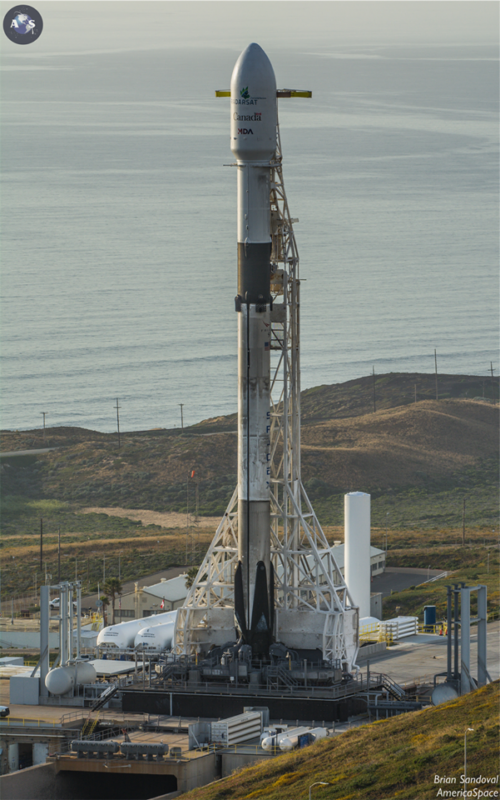
Its first-stage B1051 core still scarred and scorched from the March 2019 launch of Crew Dragon Demo-1, the Upgraded Falcon 9 sits at Vandenberg for Wednesday’s launch. Photo Credit: Brian Sandoval/AmericaSpace
As detailed in AmericaSpace’s preview feature, the RCM has been waiting in the wings for many years, contracts having been signed between SpaceX and Canadian firm MacDonald Dettwiler and Associates (MDA)—now a subsidiary of Westminster, Colo.-headquartered Maxar Technologies, Inc.—way back in July 2013.
That contract award came less than two months before SpaceX launched its first MDA payload, the CASCade, Smallsat and Ionospheric Polar Explorer (CASSIOPE), from SLC-4E. Since this first SpaceX flight out of Vandenberg, SLC-4E has seen the launches of several other Earth-observation satellites, including NASA’s Jason-3 ocean altimetry explorer, the Gravity Recovery and Climate Experiment Follow-On (GRACE-FO) twins, Taiwan’s Formosat-5 and Argentina’s SAOCOM-1A, as well as the 75-strong Iridium NEXT global mobile communications satellite constellation.
A customary Static Fire Test of the nine Merlin 1D+ first-stage engines of B1051 took place on Saturday, 8 June, with SpaceX confirming success shortly thereafter and announcing the opening launch attempt at 7:17 a.m. PDT on 12 June, at the start of a 13-minute “window”. The RCM launch marks the 19th occasion since March 2017 that an Upgraded Falcon 9 has completed a repeat flight, with three cores—B1046, B1048 and B1049—having each flown three times.
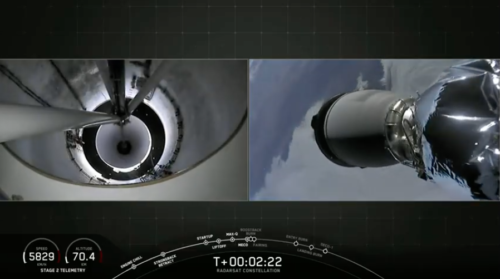
The Merlin 1D+ Vacuum engine of the Upgraded Falcon 9’s second stage successfully completed two “burns” to deliver the RCM payload to orbit. Photo Credit: SpaceX
Today’s mission flew from historic SLC-4E at Vandenberg, a facility which has supported dozens of launches over more than five decades. First used in August 1964, the mountain-ringed pad was originally known as “PALC2-4” and supported 27 Atlas-Agena flights through June 1967, delivering a network of KH-7 reconnaissance satellites to orbit. It re-entered service four years later and 22 Titan IIID boosters roared aloft from the newly-renamed “SLC-4E” between June 1971 and November 1982, launching KH-9 and KH-11 reconnaissance satellites, after which its next resident was the Titan 34D. This vehicle flew on seven occasions from June 1983 to November 1988, including a spectacular and much-publicized solid-rocket motor failure and explosion in April 1986, only weeks after the Challenger tragedy. More recently, SLC-4E supported the final generation of Titan rockets—the Titan IV—and 12 missions were staged between March 1991 and October 2005, pushing the pad’s tally to 68 launches. And after extensive upgrades in the 2011-2013 timeframe, SpaceX performed its first launch from SLC-4E in September 2013.
The three RCM birds, each weighing around 3,000 pounds (1,400 kg), were individually shipped from MDA’s facility in Montreal, Canada, to Space Systems/Loral (SS/L)—another subsidiary of Maxar—in the summer of 2018 for pre-flight storage. They were then transported to Vandenberg earlier this spring for encapsulation aboard the Upgraded Falcon 9 payload fairing. With its payload fairing attached, the 230-foot-tall (70-meter) booster was elevated to the vertical at SLC-4E on Tuesday, awaiting its early-hours Wednesday launch.
With liftoff targeted for just 90 minutes after sunrise, much of the fueling protocol occurred in the hours of darkness…and murky cloud, for the entire launch site was enshrouded in an eerie grey blanket. Loading of liquid oxygen and a highly refined form of rocket-grade kerosene (known as “RP-1”) got underway 35 minutes before the targeted opening of the window. Passing T-10 minutes in the countdown, the terminal autosequencer was initiated and the first-stage engines were chilled, preparatory to the ignition sequence. At T-2 minutes, the Air Force Range Safety Officer verified that all ground-side assets were “Go for Launch” and the vehicle transitioned to Internal Power and assumed primary control of all critical functions, entering “Startup” at T-60 seconds.
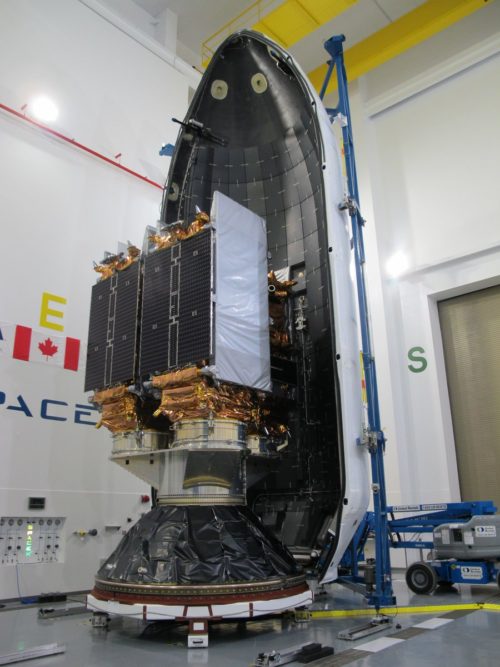
The triplets of the Radarsat Constellation Mission (RCM) are encapsulated in the Upgraded Falcon 9 payload fairing, ahead of launch. Photo Credit: Royal Canadian Air Force/Twitter
Three seconds before liftoff, the nine Merlins thundered to life, their bright reddish-orange flare slicing through the gloom, and the Upgraded Falcon 9 sprang from SLC-4E precisely on time at 7:17 a.m. PDT. Within seconds, it punched through the thick layer of low-level cloud and appeared into crystal clear blue skies.
Its first stage punched out 1.5 million pounds (680,000 kg) of thrust at T-0 and burned for 2.5 minutes before separating and beginning its long descent back to a smooth touchdown on LZ-4. Meanwhile, the second stage’s single Merlin 1D+ Vacuum engine picked up the baton to deliver the RCM trio smoothly to near-polar orbit, with an anticipated inclination of 97.74 degrees at an altitude of some 370 miles (600 km).
The second stage burned for six minutes, then shut down, after which the stack coasted for almost three-quarters of an hour. At length, a second burn positioned the Radarsat triplets for deployment. Beginning at 54 minutes into flight, the satellites were each deployed at four-minute intervals, with the last Radarsat emerging from the payload dispenser at 62 minutes after launch.
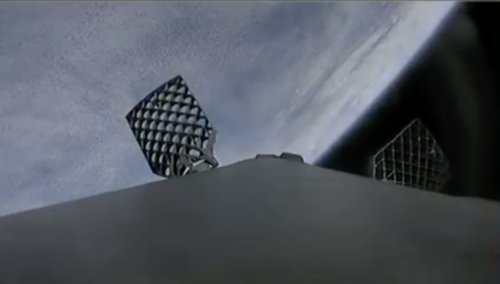
The first stage’s hypersonic grid-fins successfully deploy to provide stabilization and control during the descent phase back to LZ-4. Photo Credit: SpaceX
Orbiting at intervals approximately 30 minutes apart, the three satellites will offer complete Synthetic Aperture Radar (SAR) coverage of the entire Arctic region between four and six times daily, as well as the entire Canadian landmass at least once every 24 hours. The RCM’s rapid-revisit capability allows it to observe the exact-same view and the exact-same location on Earth’s surface once every four days, as opposed to once every 24 days presently achievable by its predecessor, Radarsat-2.
With today’s mission completed, a glance at SpaceX’s forward manifest indicates that all of the action for the remainder of 2019 will switch to the East Coast, with as many as a dozen more launches targeted to occur from Space Launch Complex (SLC)-40 at Cape Canaveral Air Force Station or Pad 39A at the Kennedy Space Center (KSC) in Florida.
Missions on the books include the forthcoming third flight of the Falcon Heavy, two Dragon cargo flights to the International Space Station (ISS) and an outsider’s possibility that SpaceX may fly its first crew on Crew Dragon Demo-2 before year’s end. There are three launches currently manifested from Vandenberg in 2020: Argentina’s SAOCOM-1B radar-imaging satellite and a number of co-manifested technology payloads in the spring and the joint U.S.-European Jason Continuity of Service (CS) radar-altimetry mission—also known as Sentinel-6A—and Germany’s SARah-1 phased-array radar-imaging reconnaissance platform in the fall and winter months.





